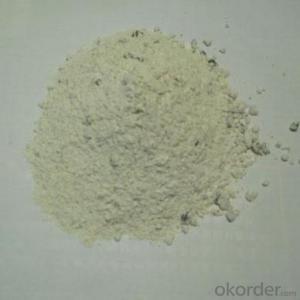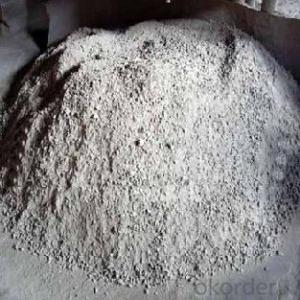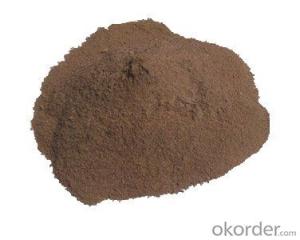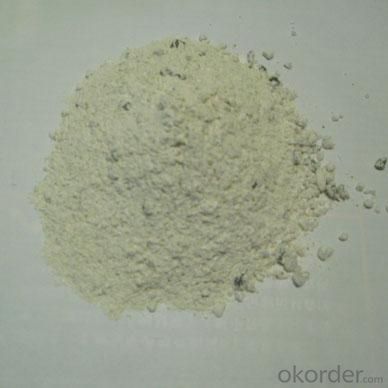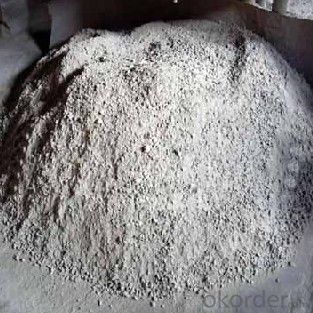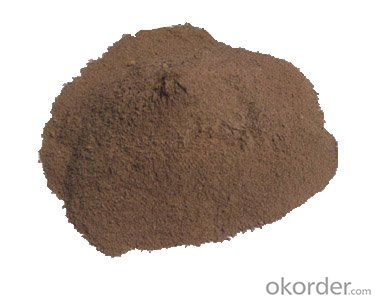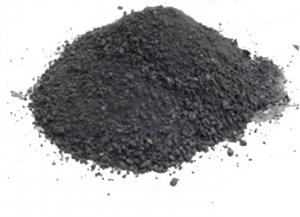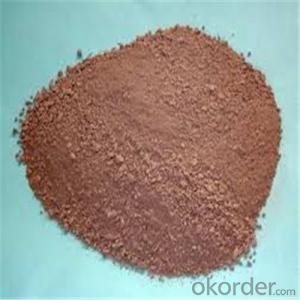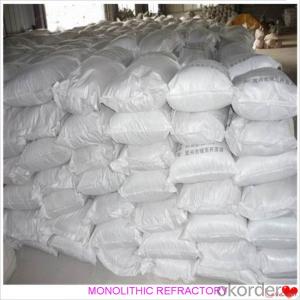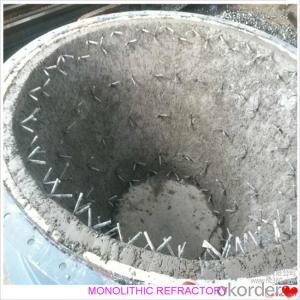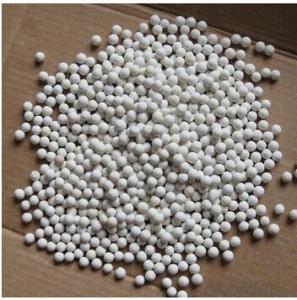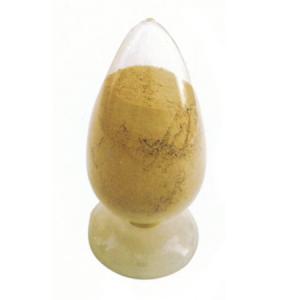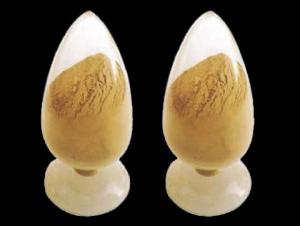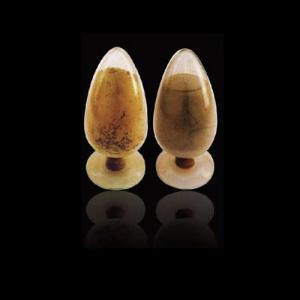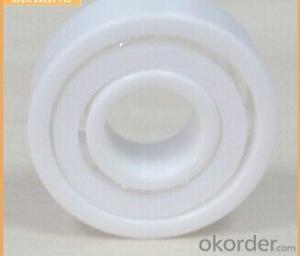Monolithic Refractories for Iron and Steel Industry - Acid Ramming Mass for Induction Furnace Lining
- Loading Port:
- Qingdao
- Payment Terms:
- TT or LC
- Min Order Qty:
- 1 m.t
- Supply Capability:
- 50000 m.t/month
OKorder Service Pledge
OKorder Financial Service
You Might Also Like
Acid Ramming Mass for Induction Furnace Lining
Product Description:
To ensure the quality of our raw materials, we only purchase our raw materials from our long-term trusted suppliers. With every purchase, our quality control staff performs the first inspection at our supplier’s site. Once the raw materials arrive at our facility, our quality control team performs a second inspection on the batch. Each time raw materials enter our facility, they are inspected again prior to being accepted.
Process Quality Control:
From raw material to final product, our process control inspectors ensure that our procedures are consistently and correctly applied each step of the way. In addition to rigorous process control, our quality control team inspects the output of each process to ensure material quality and consistency. In each of our workshops, our employees understand that the output of their workshop is the input for the next manufacturing department. Therefore they have been trained to always carefully inspect the previous workshop’s work and be responsible for their own output
Product Advantages:
• Strong penetration resistance to molten steel
• Corrosion resistance, easy sintering,
• High packing density
• Professional technical staff track the progress of each project, provide construction instruction and after-sales services
• Provide personalized products, including design and production of the completed series of refractories
• Testing, inspection services
• Product consultation
Product Specifications:

Product Images:
FAQ:
Q1: Why buy Materials & Equipment from OKorder.com?
A1: All products offered by OKorder.com are carefully selected from China's most reliable manufacturing enterprises. Through its ISO certifications, OKorder.com adheres to the highest standards and a commitment to supply chain safety and customer satisfaction.
Q2: How do we guarantee the quality of our products?
A2: We have established an advanced quality management system which conducts strict quality tests at every step, from raw materials to the final product. At the same time, we provide extensive follow-up service assurances as required.
Q3: What are Abrasion Resistant Coatings?
A3: ARC's abrasion resistant coatings guard against the severe wear and erosion that can chip away your plant's bottom line. These high-performance coatings protect new equipment as well as rebuild worn equipment at a fraction of traditional replacement costs.
- Q: How do monolithic refractories protect lining in ladles and tundishes?
- Monolithic refractories play a crucial role in protecting the lining in ladles and tundishes through their unique properties and characteristics. These refractories are composed of a single, solid piece, as opposed to traditional brick or tile linings, which consist of individual units. One of the key ways in which monolithic refractories protect the lining is through their high density and low porosity. This property ensures that the refractory material acts as an effective barrier against the penetration of molten metal and slag. By preventing the infiltration of these corrosive substances, the monolithic refractory shields the lining from chemical attack, ensuring its longevity and performance. Additionally, monolithic refractories have excellent thermal shock resistance. Ladles and tundishes are subjected to extreme temperature fluctuations during the steelmaking process, as molten metal is poured and then allowed to cool. The ability of monolithic refractories to withstand these rapid temperature changes without cracking or spalling is vital in protecting the lining from thermal damage. Furthermore, monolithic refractories offer superior strength and mechanical properties. Ladles and tundishes are subjected to various mechanical stresses, such as the weight of the molten metal, the movement of the refractory lining during pouring, and the impact of scrap or additives. The robustness of monolithic refractories allows them to withstand these forces, preventing any structural failure or damage to the lining. Another advantage of monolithic refractories is their ease of installation. Unlike brick or tile linings, which require meticulous jointing and careful placement, monolithic refractories can be applied as a single, cohesive layer. This seamless application ensures a uniform protective barrier, eliminating weak points or gaps that could compromise the lining's integrity. In summary, monolithic refractories protect the lining in ladles and tundishes by providing a dense, impermeable barrier against the penetration of molten metal and slag. Their thermal shock resistance, mechanical strength, and easy installation contribute to the overall durability and longevity of the lining, ensuring its effective performance in the demanding steelmaking environment.
- Q: How do monolithic refractories resist abrasion in the iron and steel industry?
- Monolithic refractories, with their unique composition and properties, are specifically designed for the iron and steel industry to resist abrasion. Made from a single homogeneous material, they exhibit exceptional strength and durability when subjected to continuous abrasion. The high density of monolithic refractories is one of the key factors contributing to their abrasion resistance. These refractories are manufactured with tightly packed particles, resulting in a solid and compact structure. This density minimizes wear and tear caused by the constant movement of materials like iron and steel. Furthermore, monolithic refractories often contain high levels of alumina, known for its excellent resistance to abrasion. Alumina is a highly refractory material that can withstand high temperatures and mechanical stress without deteriorating. Its presence in monolithic refractories creates a protective layer that resists abrasion caused by the movement and impact of iron and steel particles. In addition, monolithic refractories can be designed with specific additives and binders that further enhance their resistance to abrasion. These additives may include silicon carbide, mullite, or zirconia, which are renowned for their superior mechanical strength and ability to withstand wear. The binders used in the manufacturing process also contribute to the refractory's integrity and its ability to resist abrasion by providing a cohesive structure. In conclusion, the combination of high density, alumina content, specialized additives, and binders makes monolithic refractories highly resistant to abrasion in the iron and steel industry. They can withstand the harsh conditions and constant movement of materials, ensuring long-lasting performance and efficiency in various applications within the industry.
- Q: How do monolithic refractories withstand the chemical attacks in aluminum furnace applications?
- Monolithic refractories withstand chemical attacks in aluminum furnace applications due to their high resistance to oxidation and corrosion. They are specifically designed to withstand the harsh environment of aluminum processing, which involves exposure to molten aluminum, alkaline fluxes, and other corrosive chemicals. Monolithic refractories have excellent chemical stability, low porosity, and high thermal shock resistance, which allows them to maintain their structural integrity and protect the furnace lining from chemical erosion. Additionally, these refractories often contain additives such as antioxidants and anti-corrosion agents that further enhance their resistance to chemical attacks in aluminum furnace applications.
- Q: What are the recommended drying procedures for monolithic refractories?
- The recommended drying procedures for monolithic refractories vary depending on the specific type and composition of the refractory material. However, there are some general guidelines that can be followed. Firstly, it is important to remove any excess moisture from the refractory material before drying. This can be done by storing the refractory in a dry environment or using a dehumidifier if necessary. Once the refractory is adequately dried, the drying process can begin. It is recommended to start with a low drying temperature to prevent cracking or spalling of the refractory. Gradually increase the temperature over time to allow for the gradual release of moisture. This can be done by using a controlled drying oven or furnace. The drying time will vary depending on the thickness and composition of the refractory. It is important to follow the manufacturer's guidelines for the specific refractory material being used, as they will provide the recommended drying time and temperature range. During the drying process, it is important to monitor the refractory closely for any signs of cracking or spalling. If any cracks or damage occur, the drying should be stopped immediately to prevent further damage. It may be necessary to repair or replace the damaged areas before continuing with the drying process. Once the refractory is fully dried, it is important to slowly cool it down to prevent thermal shock. This can be done by gradually reducing the temperature over time or allowing the refractory to cool naturally in a controlled environment. Overall, the recommended drying procedures for monolithic refractories involve gradually increasing the temperature over time, monitoring for any signs of damage, and slowly cooling down the refractory to prevent thermal shock. It is important to follow the manufacturer's guidelines and recommendations for the specific refractory material being used to ensure proper drying and optimal performance.
- Q: What are the key properties of gunning mixes used for monolithic refractory repairs?
- The key properties of gunning mixes used for monolithic refractory repairs include: 1. High durability: Gunning mixes should have excellent resistance to thermal shock, abrasion, and chemical attack. This ensures that the repaired refractory material can withstand the harsh conditions in industrial furnaces and kilns. 2. High strength: Gunning mixes should have a high compressive strength to provide structural integrity to the repaired refractory lining. This is especially important in areas that are subjected to high mechanical stress or load. 3. Easy application: Gunning mixes should have good gunning properties, allowing for easy and efficient application. They should have the ability to be sprayed or gunned onto the surface to be repaired, providing a smooth and even coating. 4. Quick setting and drying: Gunning mixes should have a fast setting and drying time to minimize downtime during repairs. This ensures that the repaired refractory lining can be quickly put back into service, reducing production losses. 5. Good adhesion: Gunning mixes should have excellent adhesion to the existing refractory material. This ensures a strong bond between the new repair material and the old lining, preventing any potential delamination or separation. 6. Thermal stability: Gunning mixes should have a high resistance to thermal cycling and temperature fluctuations. They should be able to maintain their structural integrity and mechanical properties even under extreme heat conditions. 7. Chemical compatibility: Gunning mixes should be chemically compatible with the materials they come into contact with, such as molten metals or corrosive gases. This ensures that the repaired refractory lining can withstand the corrosive effects of these substances. Overall, the key properties of gunning mixes for monolithic refractory repairs are focused on providing durability, strength, easy application, quick setting, good adhesion, thermal stability, and chemical compatibility. These properties ensure that the repaired refractory lining can effectively withstand the harsh operating conditions in industrial furnaces and kilns, prolonging their lifespan and reducing maintenance costs.
- Q: How do monolithic refractories perform in reheating furnace roof applications?
- Monolithic refractories prove highly effective when used on the roofs of reheating furnaces. These refractories are renowned for their outstanding ability to withstand extreme temperature conditions, making them an essential component in furnace operations. Their resistance to thermal shock ensures that they do not crack or spall, guaranteeing the long-lasting durability of the furnace roof. Moreover, monolithic refractories offer exceptional insulation properties, thereby helping to maintain the desired temperature inside the furnace. With their low thermal conductivity, they prevent heat loss and reduce energy consumption. This not only enhances the energy efficiency of the furnace but also leads to cost savings for operators. Furthermore, monolithic refractories provide excellent resistance against chemical attacks from gases and molten metals found within the furnace environment. Designed to withstand corrosive atmospheres, they effectively prevent the penetration of harmful substances, thereby extending the lifespan of the roof refractory. Additionally, monolithic refractories offer easy installation and repair options. Their ability to be cast or gunned in place allows for a seamless and precise application to the roof structure. This feature also facilitates quick and efficient repairs or maintenance, minimizing downtime and production losses. In summary, monolithic refractories are a reliable and efficient choice for reheating furnace roof applications. Their outstanding resistance to thermal shock, insulation properties, chemical resistance, and ease of installation make them the ideal solution for maintaining the structural integrity and performance of the furnace roof.
- Q: How do monolithic refractories improve the efficiency of ladle and tundish purging furnaces?
- Monolithic refractories play a crucial role in improving the efficiency of ladle and tundish purging furnaces in several ways. Firstly, monolithic refractories have excellent thermal insulation properties. This means that they can retain heat within the furnace, minimizing heat loss to the surroundings. By reducing heat loss, monolithic refractories enable the furnaces to operate at higher temperatures, which in turn leads to improved efficiency. The higher temperatures allow for better steel refining, faster heating and purging of the ladle and tundish, and overall increased productivity. Secondly, monolithic refractories offer superior resistance to thermal shock. Purging furnaces, especially ladles and tundishes, undergo rapid heating and cooling cycles due to the continuous flow of molten metal. This thermal cycling can cause traditional refractories to crack or fail, leading to reduced efficiency and increased downtime for repairs. However, monolithic refractories have the ability to withstand these extreme temperature changes, ensuring continuous operation and minimizing the need for frequent maintenance. Thirdly, monolithic refractories provide excellent resistance to chemical attacks from molten metals and slag. During the purging process, ladles and tundishes come into contact with aggressive materials that can erode the refractory lining. Monolithic refractories are specifically engineered to withstand these harsh environments, preventing erosion and prolonging the lifespan of the furnaces. This resistance to chemical attacks not only improves efficiency by minimizing refractory wear, but also ensures the production of high-quality steel with reduced impurities. Lastly, monolithic refractories offer great versatility in terms of installation and repair. Unlike traditional refractories that require complex bricklaying techniques, monolithic refractories can be easily shaped and installed, allowing for faster and more efficient lining construction. Additionally, monolithic refractories can be easily repaired or patched, reducing downtime and ensuring continuous operation of the furnace. In conclusion, monolithic refractories greatly improve the efficiency of ladle and tundish purging furnaces by providing excellent thermal insulation, resistance to thermal shock and chemical attacks, as well as ease of installation and repair. These properties allow for higher operating temperatures, reduced heat loss, increased productivity, and prolonged furnace lifespan, ultimately enhancing the overall efficiency and performance of the steelmaking process.
- Q: What are some common maintenance practices for monolithic refractories in iron and steel furnaces?
- Some common maintenance practices for monolithic refractories in iron and steel furnaces include: 1. Regular inspections: Conducting routine inspections is essential to identify any potential issues with the monolithic refractories. Inspections should be carried out by trained professionals who can assess the condition of the refractories and detect any signs of wear, erosion, or damage. 2. Repair and patching: Promptly repairing any damaged or eroded areas is crucial to prevent further deterioration and maintain the integrity of the refractories. Patching materials, such as refractory mortars or castable refractories, can be used to fill in gaps or repair small cracks. 3. Cleaning: Regularly cleaning the refractory lining helps to remove any build-up of slag, scale, or other impurities that can negatively impact the performance of the refractories. Cleaning can be done mechanically, using brushes or scrapers, or through chemical methods such as acid cleaning. 4. Thermal cycling: Controlled thermal cycling is often performed to condition and strengthen the monolithic refractories. This involves gradually increasing and decreasing the temperature of the furnace to improve the refractory's resistance to thermal shock. 5. Coating and sealing: Applying protective coatings or sealants to the refractory lining can help enhance its resistance to chemical attack, erosion, and thermal cycling. These coatings act as a barrier, preventing the penetration of molten metals or slags into the refractory material. 6. Monitoring and control: Continuous monitoring of operating conditions such as temperature, pressure, and atmosphere inside the furnace is important to prevent any sudden changes that may negatively affect the refractories. Maintaining proper control over these parameters helps to extend the life of the monolithic refractories. 7. Training and education: Providing regular training and education to furnace operators and maintenance personnel is crucial for them to understand the importance of proper refractory maintenance practices. This ensures that the refractories are handled and operated correctly, reducing the risk of premature failure. Overall, implementing these maintenance practices can significantly prolong the lifespan of monolithic refractories in iron and steel furnaces and maximize their performance, ultimately leading to improved efficiency and cost-effectiveness in the production process.
- Q: How do monolithic refractories prevent thermal shock in the iron and steel industry?
- Monolithic refractories play a crucial role in preventing thermal shock in the iron and steel industry by providing a high level of thermal insulation and resistance to extreme temperatures. Thermal shock occurs when there is a rapid and drastic change in temperature, causing stress and cracking in the refractory lining. In the iron and steel industry, where temperatures can reach several thousand degrees Celsius, the risk of thermal shock is particularly high. Monolithic refractories help prevent thermal shock by having a low thermal conductivity, which means they are able to insulate against rapid temperature changes. This insulation property allows them to withstand the extreme temperatures of the iron and steel production process without compromising their structural integrity. Furthermore, monolithic refractories are designed to have a high thermal shock resistance. This means that they can absorb and distribute the thermal stresses caused by temperature fluctuations, minimizing the risk of cracking or spalling. In addition to their thermal insulation and shock resistance properties, monolithic refractories also have excellent corrosion and erosion resistance. This is particularly important in the iron and steel industry, where the production environment is highly corrosive due to the presence of molten metals, slag, and gases. By providing a reliable and durable lining in the furnaces, ladles, and other equipment used in the iron and steel industry, monolithic refractories ensure that thermal shock is minimized. This, in turn, helps to maintain the efficiency and productivity of the production process, as well as prolong the lifespan of the equipment.
- Q: How are monolithic refractories manufactured?
- Monolithic refractories are manufactured using a specific process that involves several steps. The first step is the selection and preparation of raw materials. These raw materials usually include aggregates, binders, and additives. Aggregates are chosen based on their chemical and physical properties, while binders are used to hold the aggregates together. Additives are included to enhance specific properties of the refractory material. Once the raw materials are selected, they are mixed together in precise proportions to create a homogeneous mixture. This mixture is then blended using various techniques such as dry or wet mixing, depending on the desired characteristics of the final product. After blending, the next step is shaping the refractory material. This can be done through several methods such as casting, gunning, ramming, or spraying. Each method is chosen based on the specific application and requirements of the refractory. Once the refractory material is shaped, it undergoes a curing process. This process involves drying the material at a controlled temperature to remove any excess moisture and allow for the development of desired properties. Finally, the cured refractory material is fired in a kiln at high temperatures. This firing process helps to further strengthen the refractory and enhance its resistance to heat and other harsh conditions. Overall, the manufacturing of monolithic refractories involves careful selection and preparation of raw materials, precise blending, shaping, curing, and firing processes. This ensures the production of high-quality refractory materials that can withstand the extreme conditions found in various industrial applications.
Send your message to us
Monolithic Refractories for Iron and Steel Industry - Acid Ramming Mass for Induction Furnace Lining
- Loading Port:
- Qingdao
- Payment Terms:
- TT or LC
- Min Order Qty:
- 1 m.t
- Supply Capability:
- 50000 m.t/month
OKorder Service Pledge
OKorder Financial Service
Similar products
Hot products
Hot Searches
Related keywords
